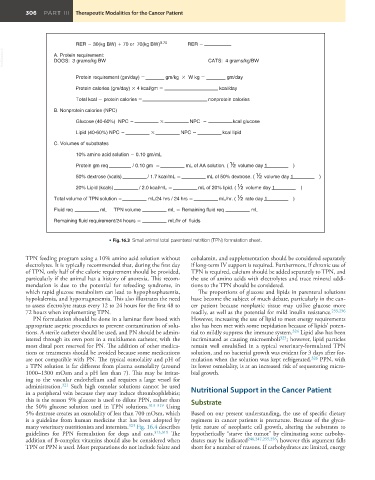Page 328 - Withrow and MacEwen's Small Animal Clinical Oncology, 6th Edition
P. 328
306 PART III Therapeutic Modalities for the Cancer Patient
RER 30(kg BW) 70 or 70(kg BW) 0.75 RER
VetBooks.ir A. Protein requirement: CATS: 4 grams/kg/BW
DOGS: 3 grams/kg BW
Protein requirement (gm/day) gm/kg W kg gm/day
Protein calories (gm/day) 4 kcal/gm kcal/day
Total kcal protein calories nonprotein calories
B. Nonprotein calories (NPC)
Glucose (40-60%) NPC NPC kcal glucose
Lipid (40-60%) NPC NPC kcal lipid
C. Volumes of substrates
10% amino acid solution 0.10 gm/mL
Protein gm req / 0.10 gm mL of AA solution. ( ½ volume day 1 )
50% dextrose (kcals) / 1.7 kcal/mL mL of 50% dextrose. ( ½ volume day 1 )
20% Lipid (kcals) / 2.0 kcal/mL mL of 20% lipid. ( ½ volume day 1 )
Total volume of TPN solution mL/24 hrs / 24 hrs mL/hr. ( ½ rate day 1 )
Fluid req mL TPN volume mL Remaining fluid req mL
Remaining fluid requirement/24 hours mL/hr of fluids
• Fig. 16.3 Small animal total parenteral nutrition (TPN) formulation sheet.
TPN feeding program using a 10% amino acid solution without cobalamin, and supplementation should be considered separately
electrolytes. It is typically recommended that, during the first day if long-term IV support is required. Furthermore, if chronic use of
of TPN, only half of the calorie requirement should be provided, TPN is required, calcium should be added separately to TPN, and
particularly if the animal has a history of anorexia. This recom- the use of amino acids with electrolytes and trace mineral addi-
mendation is due to the potential for refeeding syndrome, in tions to the TPN should be considered.
which rapid glucose metabolism can lead to hypophosphatemia, The proportions of glucose and lipids in parenteral solutions
hypokalemia, and hypomagnesemia. This also illustrates the need have become the subject of much debate, particularly in the can-
to assess electrolyte status every 12 to 24 hours for the first 48 to cer patient because neoplastic tissue may utilize glucose more
72 hours when implementing TPN. readily, as well as the potential for mild insulin resistance. 255,256
PN formulation should be done in a laminar flow hood with However, increasing the use of lipid to meet energy requirements
appropriate aseptic procedures to prevent contamination of solu- also has been met with some trepidation because of lipids’ poten-
tions. A sterile catheter should be used, and PN should be admin- tial to mildly suppress the immune system. 324 Lipid also has been
istered through its own port in a multilumen catheter, with the incriminated as causing microemboli 325 ; however, lipid particles
most distal port reserved for PN. The addition of other medica- remain well emulsified in a typical veterinary-formulated TPN
tions or treatments should be avoided because some medications solution, and no bacterial growth was evident for 3 days after for-
are not compatible with PN. The typical osmolality and pH of mulation when the solution was kept refrigerated. 326 PPN, with
a TPN solution is far different from plasma osmolality (around its lower osmolality, is at an increased risk of sequestering micro-
1000–1300 mOsm and a pH less than 7). This may be irritat- bial growth.
ing to the vascular endothelium and requires a large vessel for
administration. 321 Such high osmolar solutions cannot be used
in a peripheral vein because they may induce thrombophlebitis; Nutritional Support in the Cancer Patient
this is the reason 5% glucose is used to dilute PPN, rather than Substrate
the 50% glucose solution used in TPN solutions. 313–319 Using
5% dextrose creates an osmolality of less than 700 mOsm, which Based on our present understanding, the use of specific dietary
is a guideline from human medicine that has been adopted by regimens in cancer patients is premature. Because of the glyco-
many veterinary nutritionists and internists. 323 Fig. 16.4 describes lytic nature of neoplastic cell growth, altering the substrates to
guidelines for PPN formulation for dogs and cats. 313,319 The hypothetically “starve the tumor” by eliminating some carbohy-
addition of B-complex vitamins should also be considered when drates may be indicated 246,247,255,256 ; however this argument falls
TPN or PPN is used. Most preparations do not include folate and short for a number of reasons. If carbohydrates are limited, energy

